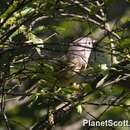en
names in breadcrumbs


The jungle babblers are a family, Pellorneidae, of mostly Old World passerine birds belonging to the superfamily Sylvioidea.[1][2] They are quite diverse in size and coloration, and usually characterised by soft, fluffy plumage and a tail on average the length of their body, or longer. These birds are found in tropical zones, with the greatest biodiversity in Southeast Asia and the Indian subcontinent.
Morphological diversity is rather high; most species resemble warblers, jays or thrushes, making field identification difficult.
The family Pellorneidae was first introduced by the French-American ornithologist Jean Théodore Delacour in 1946.[3] Pellorneidae used to be one of four subfamilies of Timaliidae (tree- and scimitar-babblers), but was then elevated to its own family rank in 2011 based on molecular markers.[4][5]
Jungle babblers are small to medium-sized birds which are on average 14 cm long and weigh around 30g, but range from 10–26 cm, and 12-36g [6]
Divided between being terrestrial and arboreal, Pellorneidae have strong legs. They usually have generalised bills, similar to those of a thrush or warbler, with the exception of the long-billed wren-babbler (Rimator malacoptilus) and both species of scimitar babbler from the Jabouilleia genus which have long, curved bills. Most jungle babblers have predominantly brown plumage with little sexual dimorphism, but brightly coloured species of this family also exist.[7] Many jungle babblers have distinctive 'eyebrows' and 'caps' which may help to differentiate them from similarly-sized and coloured species.[6]
This group is not strongly migratory, and most species have short rounded wings, and weak flight. They live in lightly wooded, scrubland, or jungle environments, ranging from swamp to near-desert. They are primarily insectivorous, although many will also take berries, and the larger, omnivorous species will even eat small lizards and other vertebrates.[7]
Jungle babblers are generally non-migratory, social birds, defined by their lack of seasonal plumage and unspotted juvenile plumage.[8] These birds tend to be shy, but a few species are highly territorial and respond to playbacks of their vocalisations.[9] Breeding behaviour is not well known for all species of jungle babbler, but some birds, such as the Streaked wren-babbler (Napothera brevicaudata) have adapted to their habitat by nesting in holes or shallow cavities in the limestone cliffs and boulders of their region.[10] Others nest on the ground or in trees or shrubs. Care of nestlings by both parents is common, and cooperative breeding is prevalent among babblers [11]
Pellorneidae are found throughout the tropics of Asia and Africa. Preferring sheltered places, these birds tend to stick to the undergrowth or forest edge.[8]
Originally placed within Timaliidae as a subfamily, Pellorneidae was elevated into family status following a closer analysis of the superfamily Sylvioidea.[1] Sylvioidea was initially considered too complex to differentiate using morphology due to multiple instances of convergent evolution, and it wasn't until molecular analysis was conducted that the superfamily was recognised to be non-monophyletic - hence Pellorneidae being recognised as a family.[1] Pellorneidae is ia sister to a clade containing the families Leiothrichidae and Alcippeidae.[12]
Another taxonomy revision was the renaming of the rufous-vented grass babbler (Laticilla burnesii) and swamp grass babbler (Laticilla cinerascens) from Prinia (in the family Cisticolidae) to Laticilla.[13] Data sequencing using mitochondrial and nuclear markers revealed that P. burnesii and P. cinerascens belonged in a different family to the other members of Cisticolidae, with the results supported by Bayesian inference[13]
The cladogram below showing the phylogenetic relationships between the families is based on a study of the babblers by Tianlong Cai and colleagues published in 2019.[12][4]
Pycnonotidae – bulbuls (160 species)
Sylviidae – sylviid babblers (34 species)
Paradoxornithidae – parrotbills and myzornis (37 species)
Zosteropidae – white-eyes (146 species)
Timaliidae – tree babblers (57 species)
Pellorneidae – ground babblers (65 species)
Alcippeidae – Alcippe fulvettas (10 species)
Leiothrichidae – laughingthrushes and allies (133 species)
The cladogram below shows the relationships between the genera.[12][4]
PellorneidaeGraminicola – grassbirds (2 species)
Turdinus – wren-babblers (3 species)
Malacopteron – babblers (6 species)
Gampsorhynchus – babblers (2 species)
Schoeniparus – fulvettas (7 species)
Pellorneum – babblers (15 species)
Laticilla – grass babblers (2 species)
Illadopsis – illadopsis (9 species)
Kenopia – striped wren-babbler
Malacocincla – babblers (3 species)
Gypsophila – wren-babblers and limestone babblers (6 species)
Ptilocichla – wren-babblers (3 species)
Napothera – wren-babblers and scimitar babblers (6 species)
The family includes 65 species divided into 13 genera:[4]
Laticilla (species moved here from Prinia in the Cisticolidae)[14]
Kenopia - monotypic
The jungle babblers are a family, Pellorneidae, of mostly Old World passerine birds belonging to the superfamily Sylvioidea. They are quite diverse in size and coloration, and usually characterised by soft, fluffy plumage and a tail on average the length of their body, or longer. These birds are found in tropical zones, with the greatest biodiversity in Southeast Asia and the Indian subcontinent.
Morphological diversity is rather high; most species resemble warblers, jays or thrushes, making field identification difficult.
The family Pellorneidae was first introduced by the French-American ornithologist Jean Théodore Delacour in 1946. Pellorneidae used to be one of four subfamilies of Timaliidae (tree- and scimitar-babblers), but was then elevated to its own family rank in 2011 based on molecular markers.